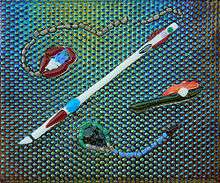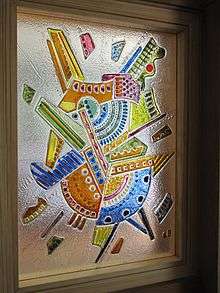Glass fusing

Glass fusing is the technique used to join glass pieces together by partly melting the glass at high temperature.[1] The fusion process requires multiple pieces of glass, with a minimum of two.[2] The heating is commonly undertaken in an electric kiln. Instead of fitting glass together using a lead solder, two or more pieces of glass are laid on top of or overlapped on each other and are fired at temperatures ranging from 1100 to 1600 degrees Fahrenheit (750 to 850 degrees Celsius).[3]

It is important to realize that glasses with different coefficients of expansion or viscosity cannot be fused together. Upon cooling or after a period of time, the fused piece will crack. Many people who work in glass fusing restrict themselves to one brand of glass (e.g. Bullseye Glass, Uroborus, Baoli, Spectrum) which is guaranteed to be compatible with any other fusible glass offered by that particular maker.[4] Molds can also be used in glass fusion, this is a process called slumping, glass is laid over the mold (generally made of ceramic or metal) and forms to it creating pieces such as plates and candle holders.[5]
Use of glass fusion in Art Therapy
Glass fusion is rarely used in art therapy. However, Somer and Somer suggest that properties of glass provide metaphors useful in the therapy process, including the clarity of the glass, the act of breaking, and reflections seen in glass.[6]
See also
References
- ↑ Glass fusing basics. (n.d.) Retrieved from http://www.bullseyeglass.com/education/fusing-basics.html
- ↑ http://fusedglass.org/learn/what_is_fused_glass
- ↑ http://fusedglass.org/learn/what_is_fused_glass
- ↑ "Glass Fusing and Sumping Information". www.glass-fusing-made-easy.com. Retrieved 2008-05-21.
- ↑ http://www.glass-fusing-made-easy.com/molds.html
- ↑ Somer, L. & Somer, E. (2000). Perspectives on the use of glass in therapy. American Journal of Art Therapy. 38:75-80.